Um Ihnen ein optimales Erlebnis zu bieten, verwenden wir Technologien wie Cookies, um Geräteinformationen zu speichern und/oder darauf zuzugreifen. Wenn Sie diesen Technologien zustimmen, können wir Daten wie das Surfverhalten oder eindeutige IDs auf dieser Website verarbeiten. Wenn Sie Ihre Einwillligung nicht erteilen oder zurückziehen, können bestimmte Merkmale und Funktionen beeinträchtigt werden.
Die technische Speicherung oder der Zugang ist unbedingt erforderlich für den rechtmäßigen Zweck, die Nutzung eines bestimmten Dienstes zu ermöglichen, der vom Teilnehmer oder Nutzer ausdrücklich gewünscht wird, oder für den alleinigen Zweck, die Übertragung einer Nachricht über ein elektronisches Kommunikationsnetz durchzuführen.
Die technische Speicherung oder der Zugriff ist für den rechtmäßigen Zweck der Speicherung von Präferenzen erforderlich, die nicht vom Abonnenten oder Benutzer angefordert wurden.
Die technische Speicherung oder der Zugriff, der ausschließlich zu statistischen Zwecken erfolgt.
Die technische Speicherung oder der Zugriff, der ausschließlich zu anonymen statistischen Zwecken verwendet wird. Ohne eine Vorladung, die freiwillige Zustimmung deines Internetdienstanbieters oder zusätzliche Aufzeichnungen von Dritten können die zu diesem Zweck gespeicherten oder abgerufenen Informationen allein in der Regel nicht dazu verwendet werden, dich zu identifizieren.
Die technische Speicherung oder der Zugriff ist erforderlich, um Nutzerprofile zu erstellen, um Werbung zu versenden oder um den Nutzer auf einer Website oder über mehrere Websites hinweg zu ähnlichen Marketingzwecken zu verfolgen.

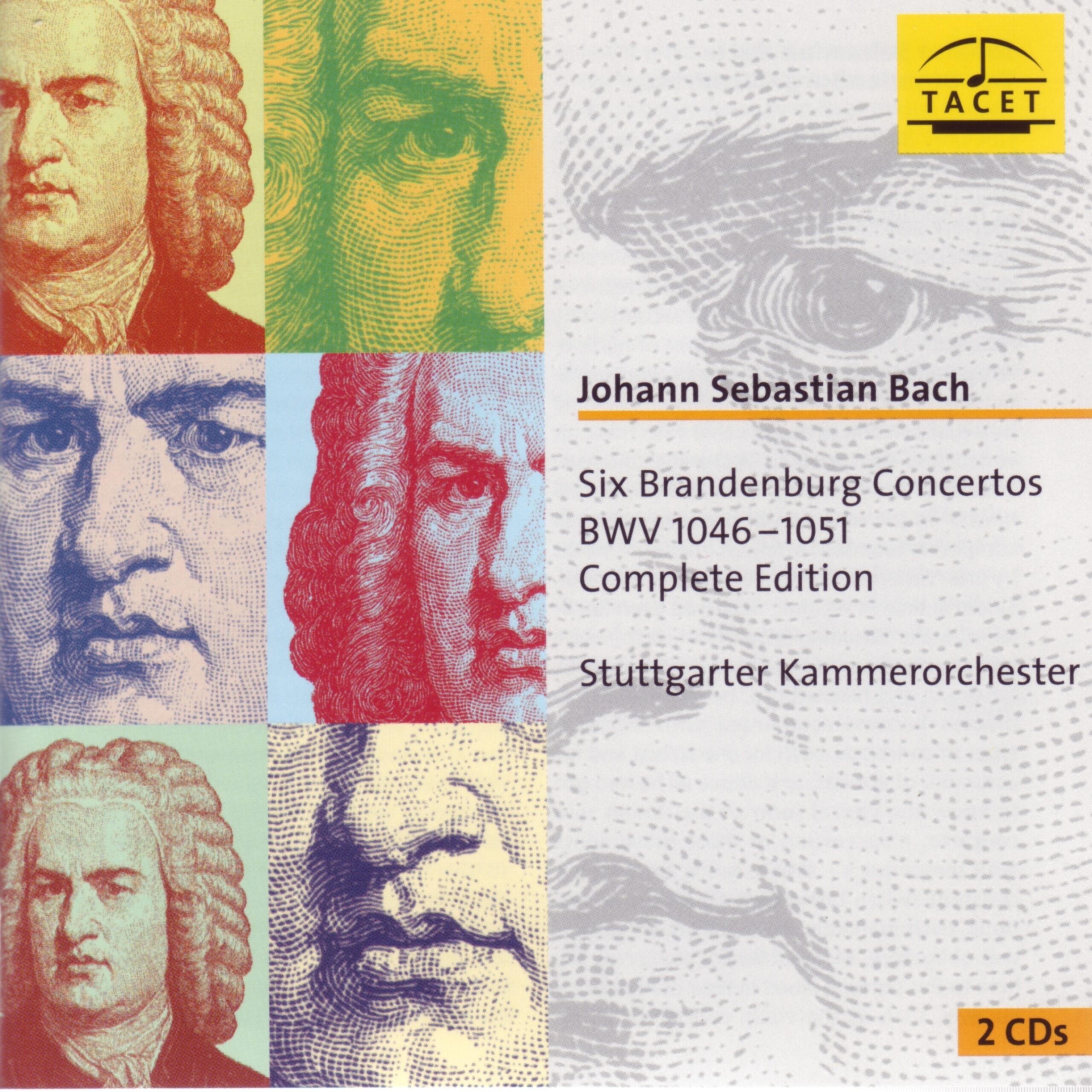
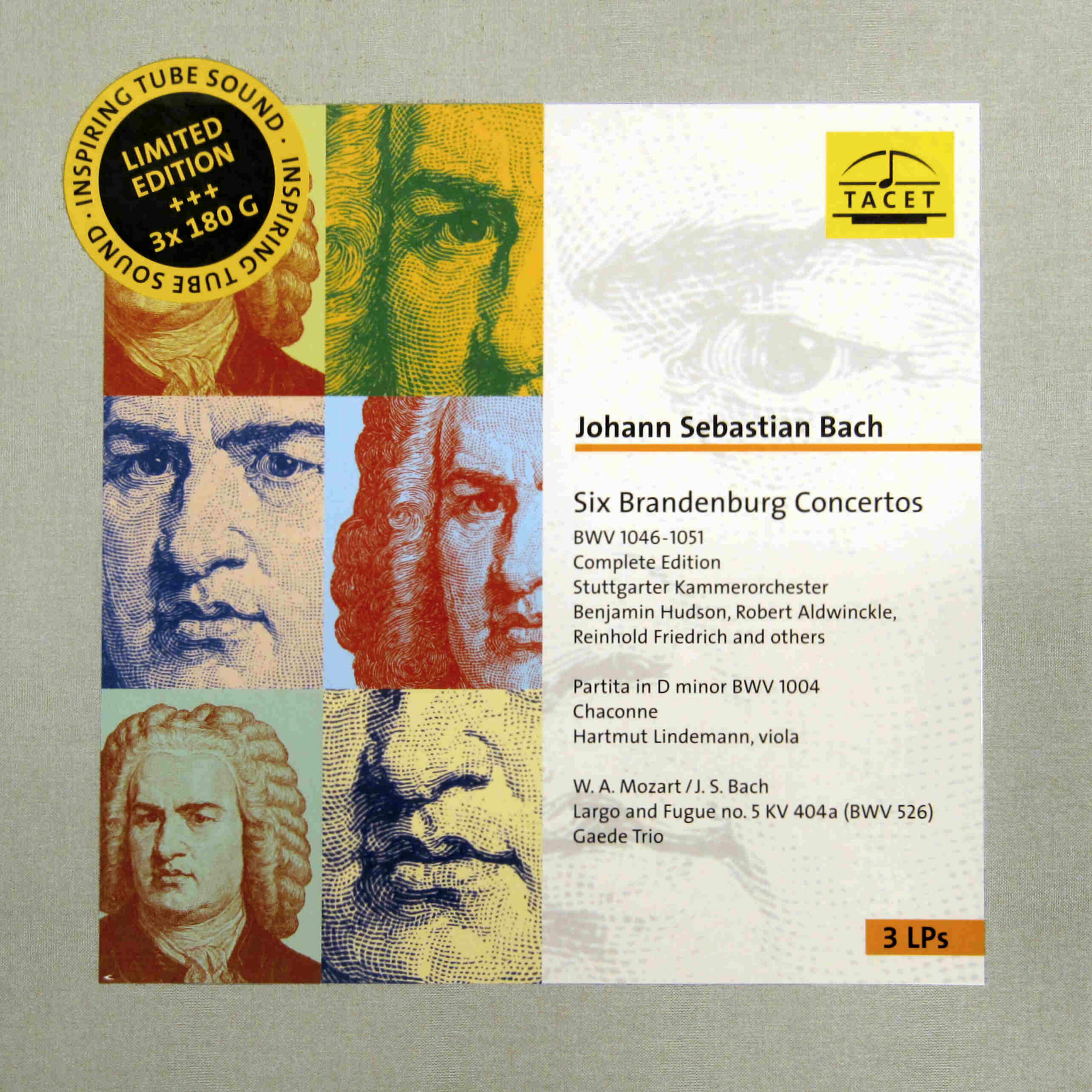
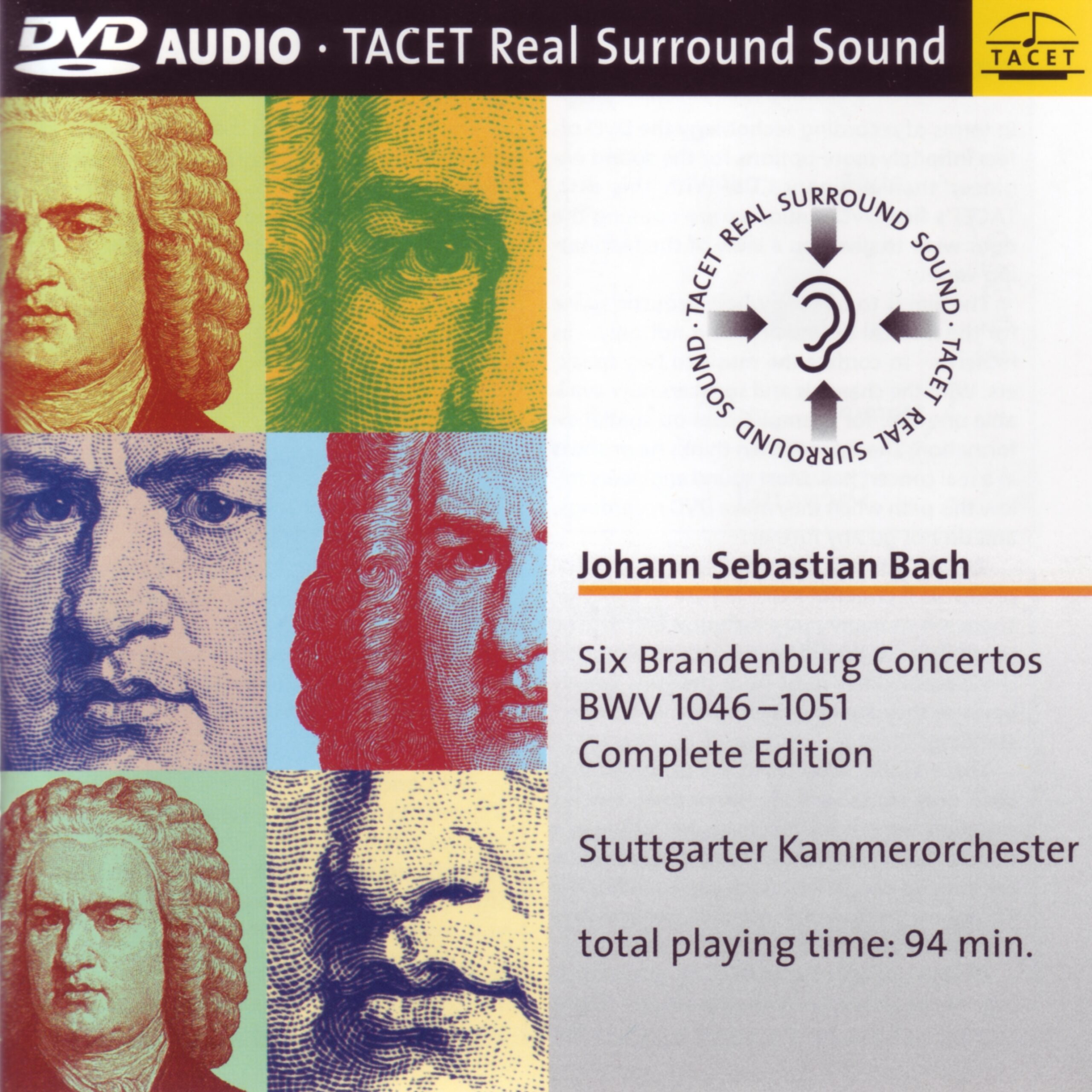
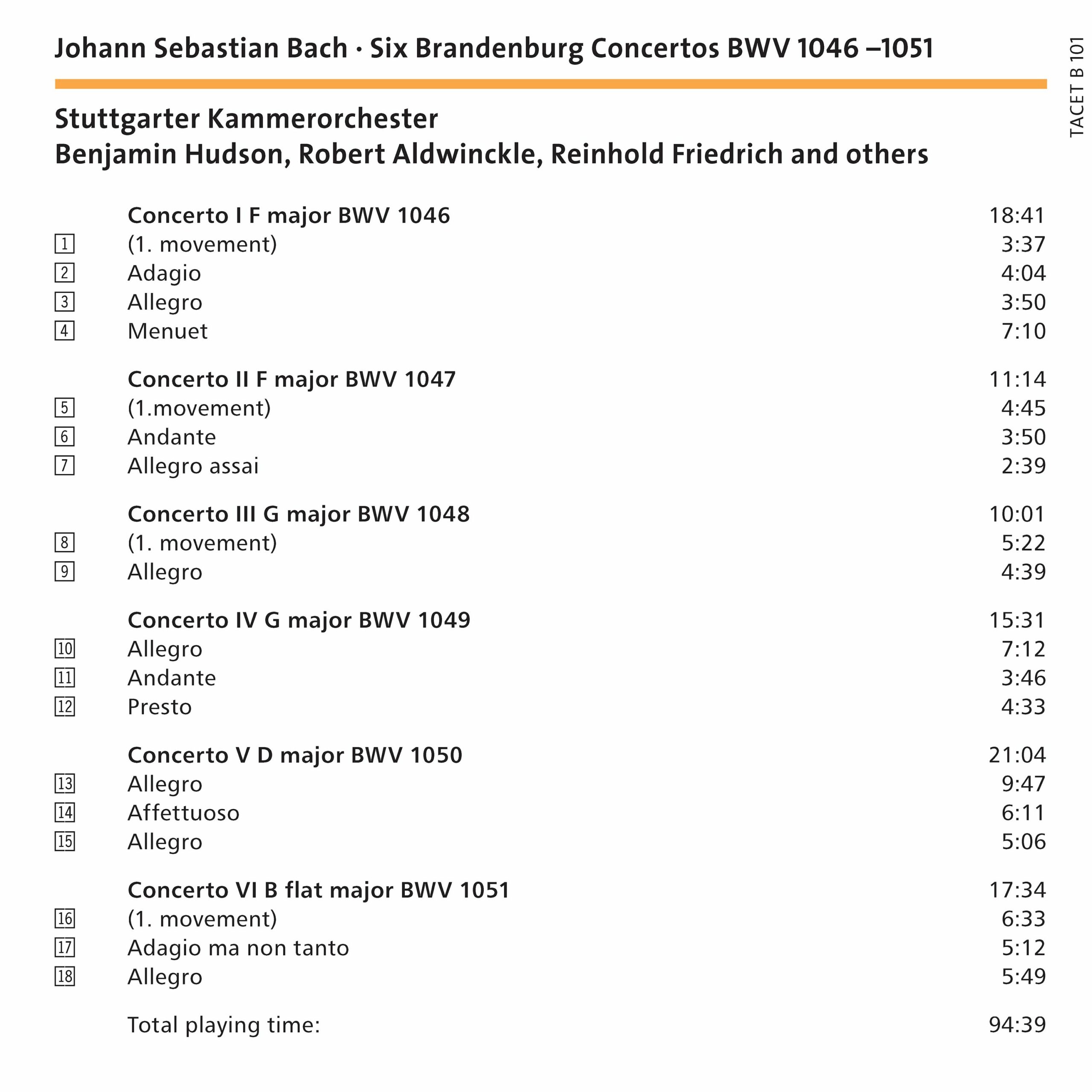
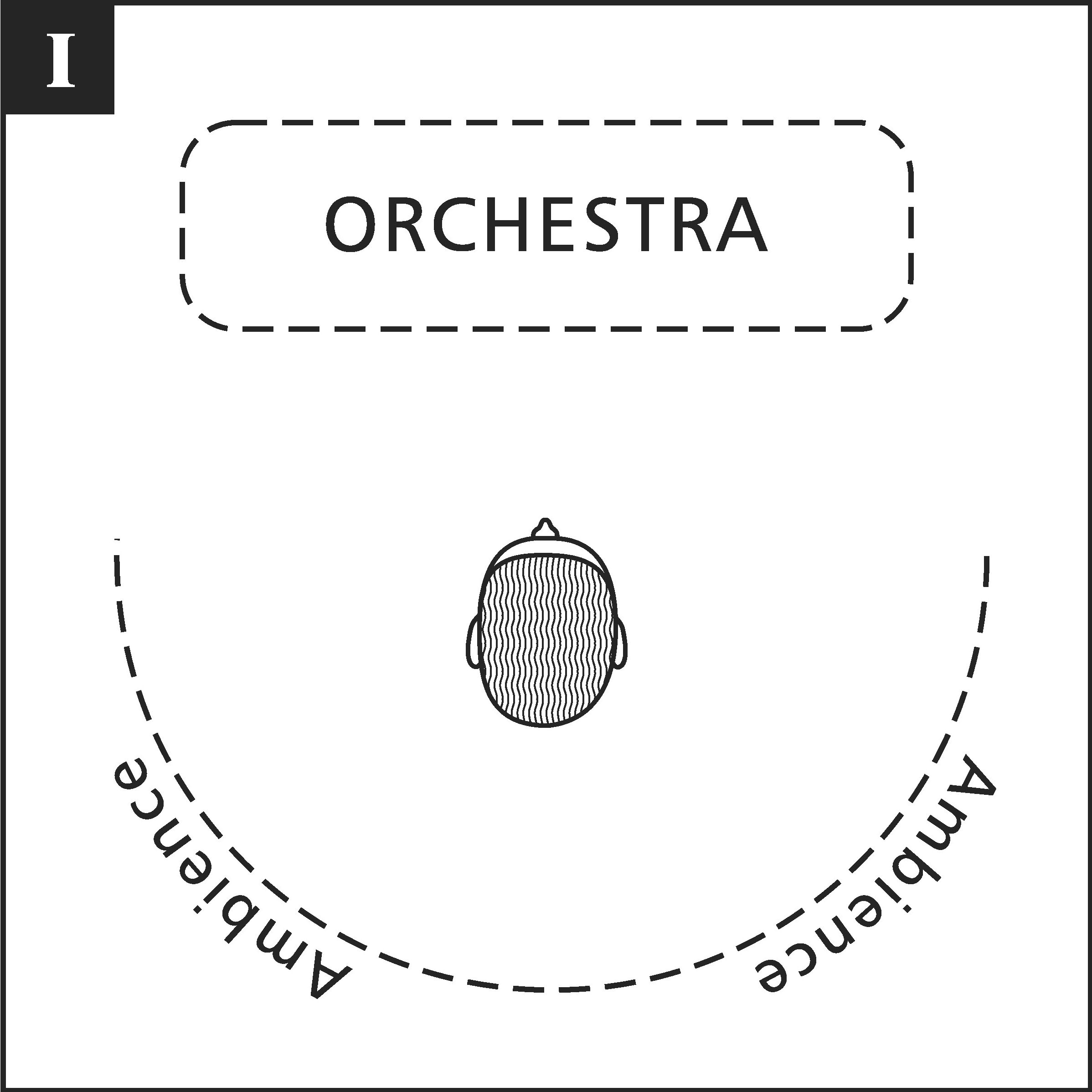
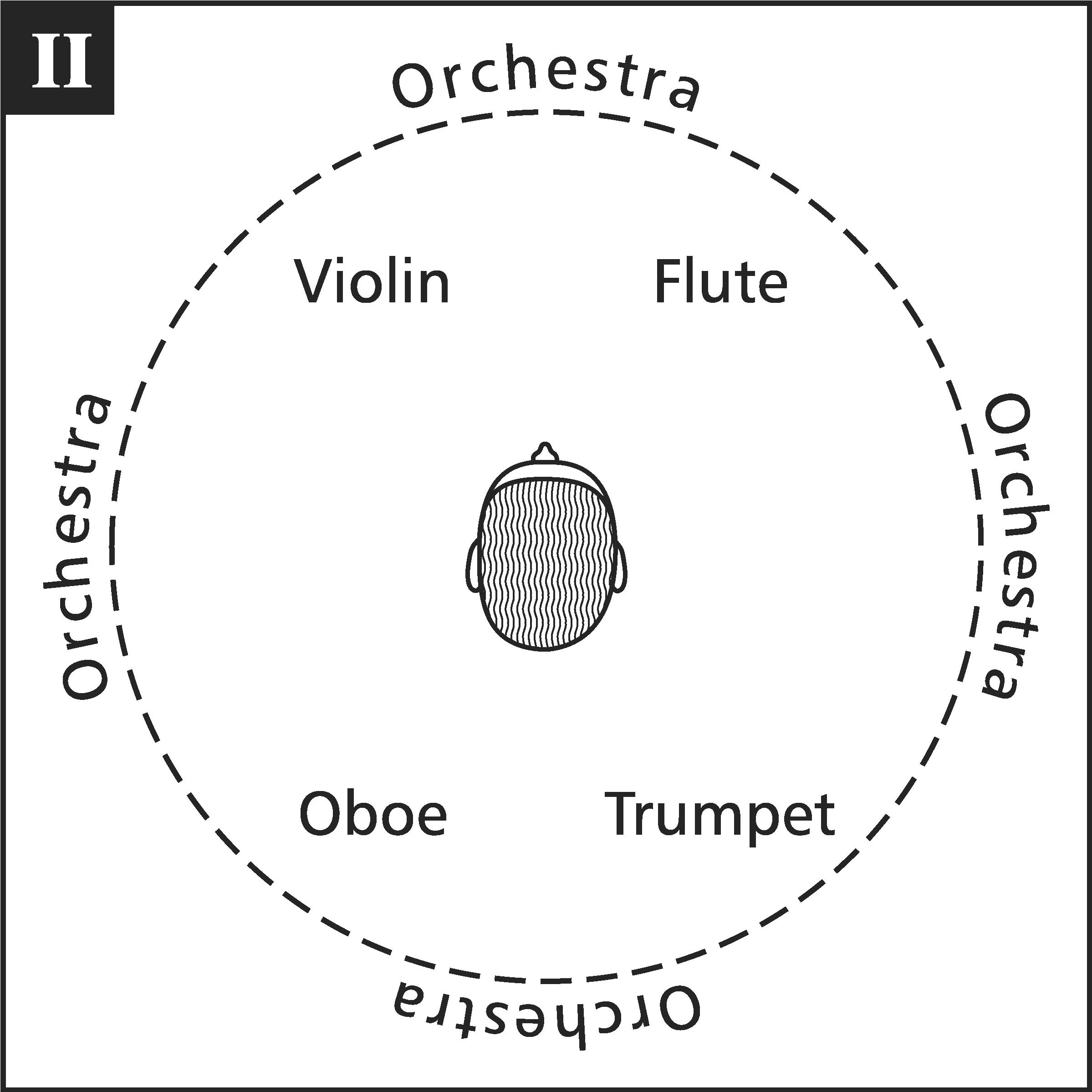
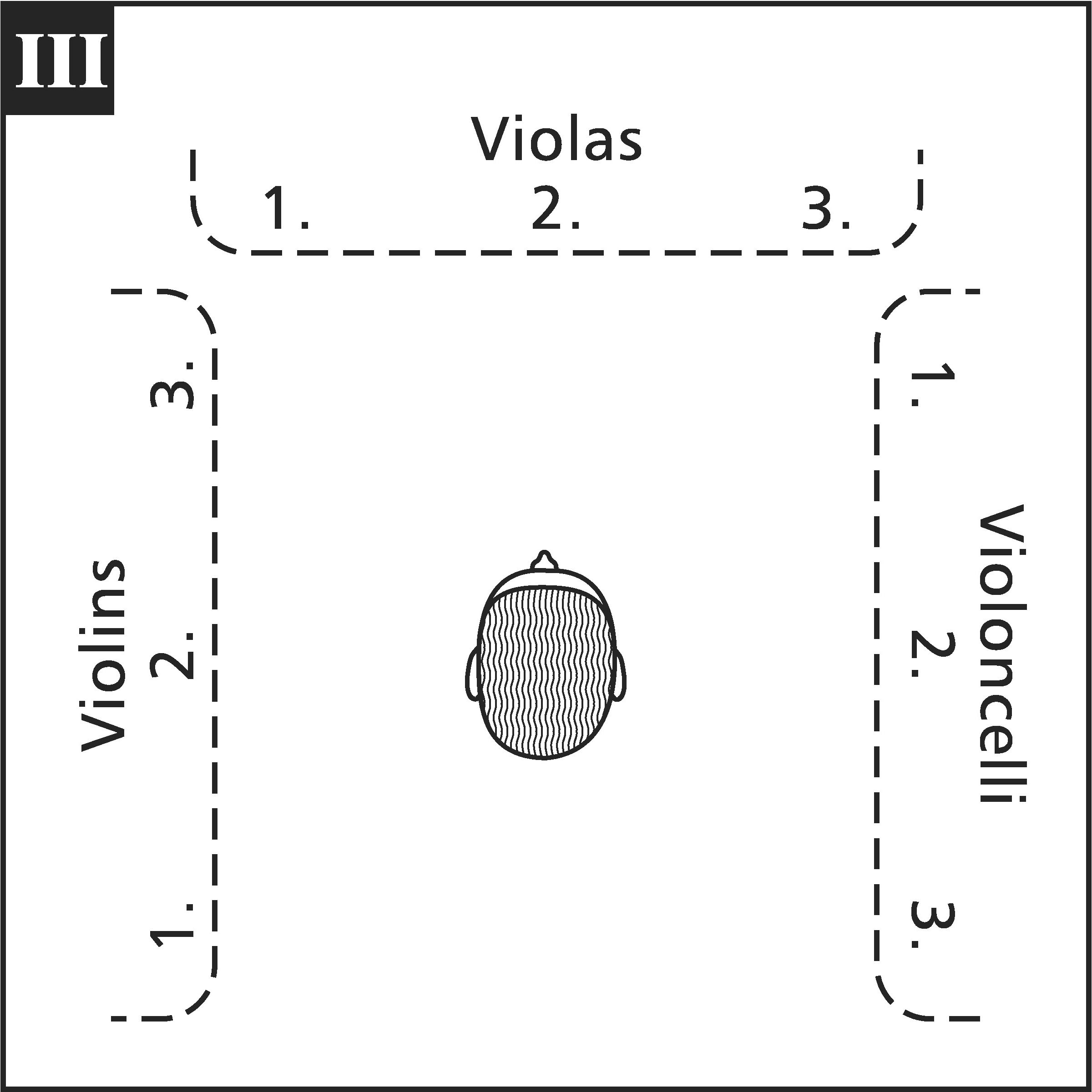
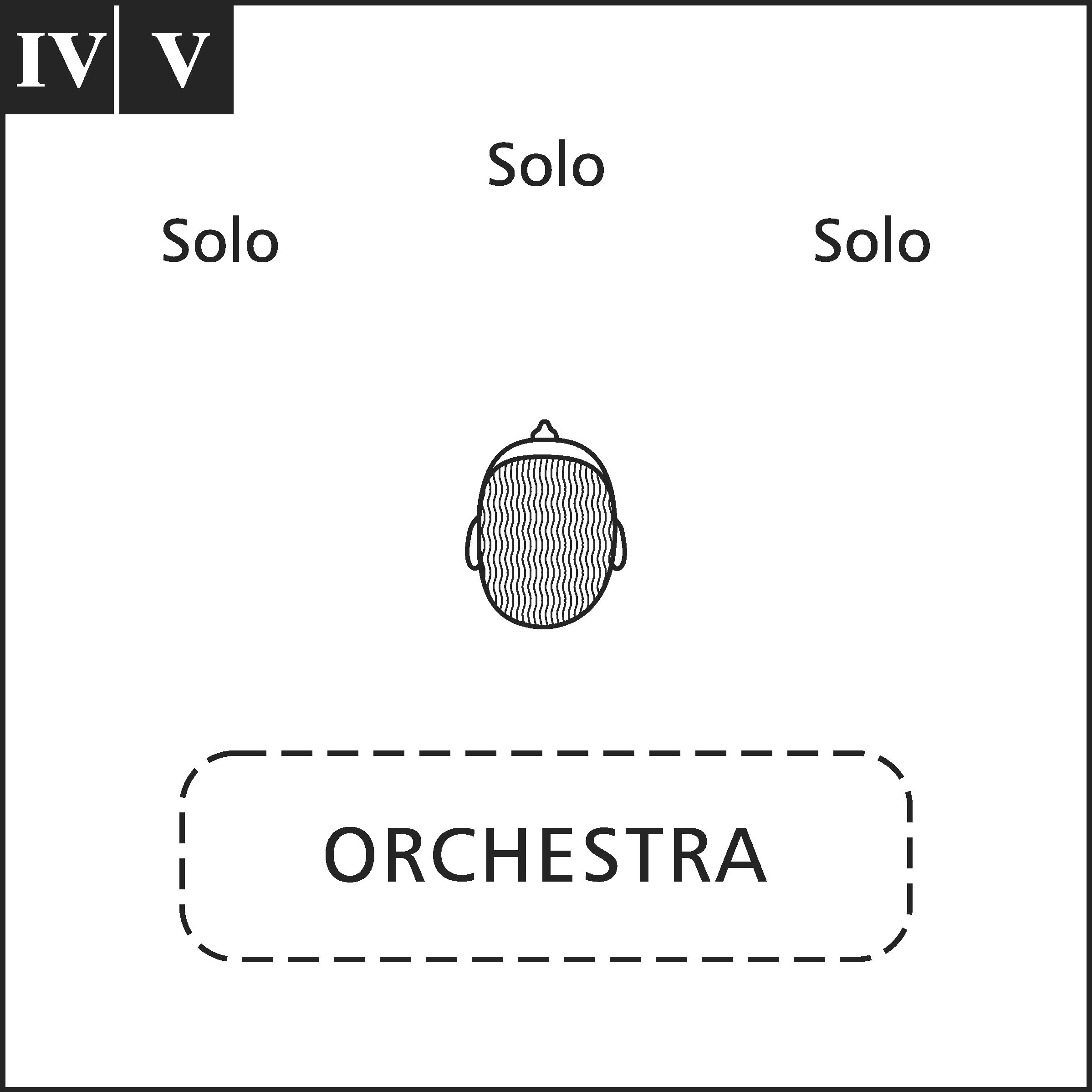
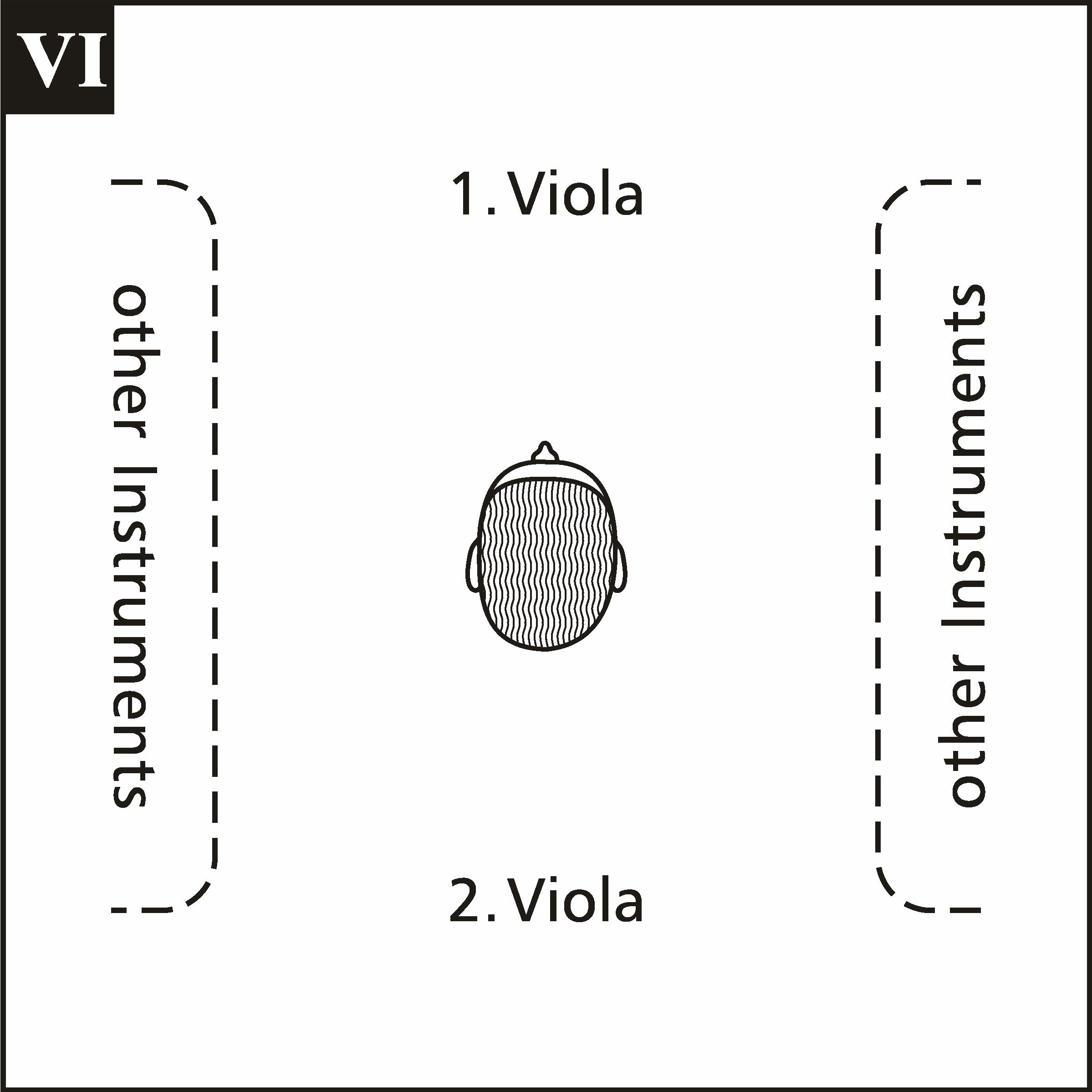
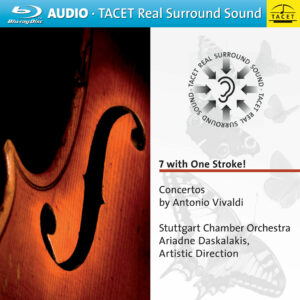
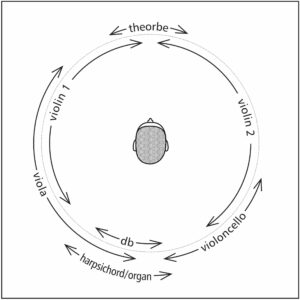
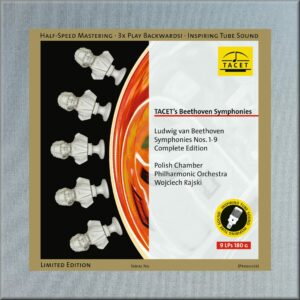
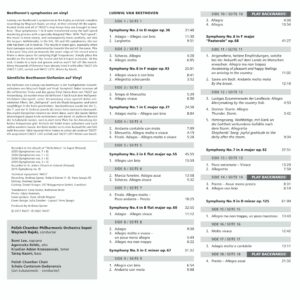
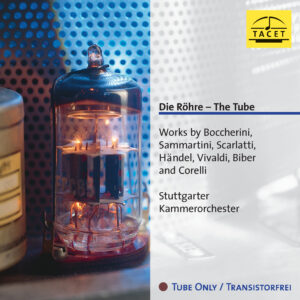
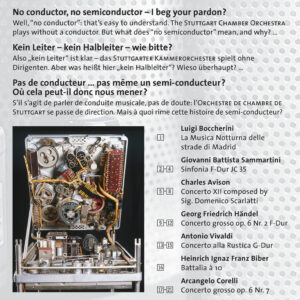

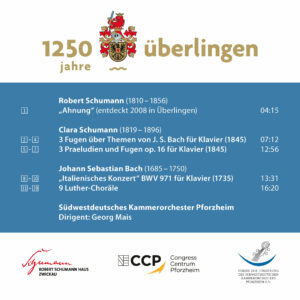
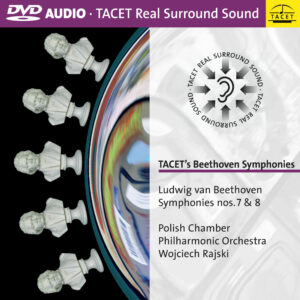
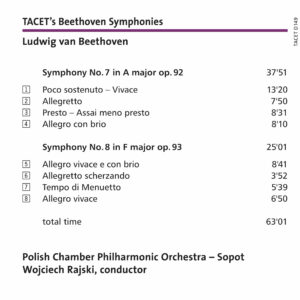
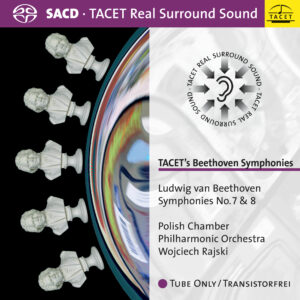
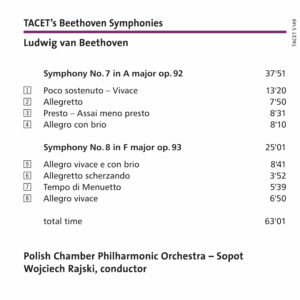
sa-cd.net –
I have just experienced some joyful playing on modern instruments of one of the greatest collection of orchestral works written. The tempi are not in any way slow (except to those who are now 100% acclimatised to period instruments) and nor is any of the phrasing romantically self-indulgent. The tuning is also of a very high standard and nowhere did I find my sensibilities jarring through bad playing. Instead of piano (as some modern instrument sets used to employ) a harpsichord, tastefully balanced, is given the task of fleshing out No.5 and the continuo role elsewhere, which it does admirably. Almost full marks for the performances on their own terms, although those seeking period instruments had better look elsewhere.
The sound, whilst beautifully recorded and balanced (in the sense that every instrument can be heard) is much more controversial. As this was recorded as a "Real Surround Sound" issue, each concerto has a different seating arrangement which some (but not me) might feel detract from the musical experience & they are detailed below:
1 - Normal (orchestra "front", ambience "rear")
2 - The listener is situated in the middle of the ensemble with violin (front L), flute (front R), oboe (rear L) & trumpet (rear R) in the foreground compared to the orchestra
3 - The violins are on the left, violas in front, celli to the right of the listener
4 & 5 - The three soloists for each concerto are placed front L, centre & front R with the orchestra seated behind the listener
6 - The soloists are placed directly in front of and behind the listener with the orchestra split either side.
Whilst this is certainly a way of hearing it that no-one would ever experience in concert (except as a performer perhaps), once the initial shock has worn off the effect is most pleasing with all details coming naturally to the fore and it is very pleasing to hear all the solo lines so clearly. This is also, in large part, due to the slim-line string forces employed by the Stuttgarter Kammerorchester – 5, 4, 4, 3, 1 – and the magnificent unanimity of ensemble on display which is entirely at the disposal of Bach’s magnificent creations.
The 2 channel layer adopts the balance from 1 throughout (not that it would be possible to do otherwise!) and is thoroughly beautiful and realistic.
Highly recommended unless an avid MCH fan & the thought of separate seating arrangements puts you off.
John Broggio
Bangkok Post realtime –
A triumph of surround sound recording
Whatever the woes of the classical recording industry, listeners can evidently continue to count on small, creative labels to come through with choice new offerings. One such company, the German label Tacet, seems to specialise in the extraordinary, in terms of both performance and recorded sound.
Some weeks back I wrote admiringly in this column about their discs of keyboard works by J. S. Bach played on the piano by Valentin Koroliov. Many further listenings have intensified my feeling that his recorded accounts of Books I and II of The Well- Tempered Clavier are second to none. Recently I obtained several more Tacet releases, including surround-sound DVD recordings of more music by Bach, a single-disc set of the Brandenburg Concertos and another of the motets. This is the same performance (by Matthias Jung conducting the Saechsisches Vocalensemble) discussed here recently in its stereo version. I have also begun to investigate Tacet′s series of recordings by the Auryn String Quartet, but more about those in a future column.
The idea of recording the Brandenburg Concertos in surround sound initially struck me as dubious, especially since Tacet had clearly conceived this disc with the idea of demonstrating the technology. Different microphone placements were used for different concertos so that in the First Concerto, for example, a natural perspective is created by placing the entire orchestra in front of the listener with the rear speakers creating ambience. In the Second Concerto the solo violin is front left, the solo flute front right, the oboe back left, and the trumpet back right, with the remaining instruments in the middle. This kind of fiddling with space and balance has produced sonic monstrosities in the past. Long-time listeners will still recall with a groan the ping-pong effects perpetrated by the engineers of early stereo recordings, and the bizarre and unconvincing distortions of normal perspective inflicted on listeners by some of the quadraphonic recordings released during the 1970s. But I had no such feelings of something potentially interesting gone wrong while listening to these Brandenburgs, despite the fact that only one of the six recordings claims to resemble anything that might be heard in a concert setting.
When listening to the Surround Sound recording of the First Concerto, the notes promise that you are sitting in the wonderful church in the village of Goenningen and listening to the Baroque acoustics. Conditions in that church would have to be ideal indeed for a listener to hear the music with the clarity and warmth that it has in this recording. Everything is clearly and naturally audible, but there is a feeling of perfect balancing and blending that I′ve rarely experienced even in good multi-channel recordings of Baroque music. Given the technology that we have now, I don′t know how it could be improved upon.
Any illusion of being in a conventional performance space disappears while listening to the other five concertos, but it is replaced by a very different and often thrilling kind of listening experience, that of being surrounded by the musicians as they play. It may sound like the height of artificiality to have the violin, flute, oboe, and trumpet coming at you from four different directions as you listen to the Second Concerto, but the engineers have managed it in a way that creates the illusion that no chilly electronic channeling has been done. There is no feeling that the soloists have been highlighted in the recording process. The music envelops you completely and every player seems positioned naturally in the complex of sound.
The recordings of the Fourth and Fifth concertos also draw strong attention to the special recording technique Tacet uses for this disc. Both place the soloists in front of and the orchestra behind the listener. I was a little skeptical as the fugal third movement of the Fourth Concerto began, with the two opening voice entries coming from squarely behind me and the sonic space spreading to the front of the room only with the entries of the solo flutes and violin. But my doubts quickly disappeared as the performance continued. The passage following the violin solo, where the texture becomes so busy that the instruments seem to be playing themselves just to express their energy and high spirits, is thrilling when heard in this detail. Once again, despite the configuration of the players there is a real sense of ensemble, and the music gives no impression of being laid out on a dissecting table. It′s alive and very healthy.
The performances in themselves are terrific. Many listeners may wonder if they really need another recorded set of the Brandenburgs, especially with such gems as those by Pinnock/English Concert, Savall/Le Concert des Nations, and the Akademie fuer Alte Musik Berlin possibly already on their shelves. The answer is: yes, there is always room in any collection for a disc like this one. The Stuttgart Kammerorchester have made many fine recordings of Bach′s music under the baton of Karl Muenchinger, including an Art of Fugue to treasure. Here, it is in leaner, springier and more cleanly focussed form than it was in its Decca days. Benjamin Hudson, who leads them in these performances, favours tempos that are fast but never rushed. The instruments sound like modern ones, but the textures have the clarity of those heard in period instrument performances, so quickly-paced movements can really fly without sounding strained. The final movement of the Third Concerto is taken at an extremely fast tempo, but there is no feeling of the music being rushed; it is just irresistibly exciting.
The recording of the Fifth Concerto, with the harpsichord in front and the orchestra in back, could have been a disaster if Super Harpsichord, heard in so many recordings of this piece, had appeared here. But the harpsichord used is a delicate-sounding instrument whose sonority is absorbed naturally into the ensemble.
I played this disc on a Sony DVD player using a Yamaha RX-V740 6.1 surround sound system, the same one I use for DVD movies, and the results were quite stunning.
Ung-aang Talay
Audiophile Audition –
I have been a Brandenburg junkie for ~50years . From my first Westminster LP set with Karl Haas conducting The London Baroque Ensemble, to my favorite Decca recording with the English Chamber Orchestra led by Benjamin Britten, my Brandeburg recordings have been played en chambre, al fresco, and en passant, in auto or on foot. They are an integral part of my essential whistling repetoire- as in the third concerto where I dare to go where no whistler ought - with that trumpet solo.
This Tacet set achieves yet another level of excellence! Utilizing SACD five channel technology, the listener is presented differing instrumental placements for the various concertos. The first Brandenburg with horns, winds, abd strings finds the orchestra in "standard" position with the rear channels adding ambiance. The second concerto places the listener inside the orchestra. The trumpet is R. rear, the oboe L. rear, the flute R. front, the violin L. front, while the remaining orchestra is arrayed around the listener. The effect is quite thrilling. The voices and counterpoint are so clear. It is as if you are inside of Bach′s brain. And what a brain this is! The insight this technique provides into the interlocking melodies and harmonies is one of the most exciting musical experiences that I have encountered.
The third concerto finds the violas front, the cellos and violins R and L respectively. Again, the most remarkable clarity is provided; indeed,clarity is the essence of these recordings .In particular the second third and fourth concertos are most effective. I know my Brandenburgs and am astonished by the information available only from these discs.
The Stuttgart Chamber Orchestra recorded a fine set of Brandenburgs for Decca/London in the 1960s under the direction of Karl Munchinger. It was highly esteemed and remains available at record boutiques.This 2000 Stuttgart recording, without designated conductor, is more idiomatic, more gracefully performed, more spirited and more virtuosic with respect to the soloists′ contributions. Combine these gorgeous performances with the opportunity of literally being inside the 6 Brandenburgs in surround sound and you have a most remarkable listening experience.
Excitingly recommended! [We reviewed the DVD-Audio version of this not long ago in these same pages. Sonics are similar; the main difference is that in that case all the concertos fit on a single DVD...Ed.]
Ronald Legum
Audiophile Audition –
The Stuttgart performers display a highly attractive balance of authentic performance practice, faster tempi and a generally more fun approach to the concertos. They are aided by cleaner, crisper, higher resolution sonics that really put you into the middle of the performing ensemble. The label′s slogan is Real Surround Sound and they mean it - the surrounds are not limited to subtle hall ambience here at all. This release gives me a much greater appreciation for the DVD-A format than I previously had.
John Sunier
Stereo –
All-round beauty
The classical label TACET is bringing the first multi-channel DVD productions to market
It was about time that serious music producers engaged with the aesthetic rethinking required for multi-channel recordings. The often well-founded skepticism toward surround sound—frequently regarded as superfluous or even nonsensical—is widespread among audiophile music fans.
Sound engineer and TACET head Andreas Spreer sees it differently, and at this year’s HighEnd he presented new multi-channel DVDs intended to counter these reservations. In a special demonstration, STEREO was able to experience the classical producer’s approach to sound. “We work very closely with the score and distribute the orchestra and soloists very carefully around the listener. This creates new perspectives and certainly also a new sonic aesthetic,” Spreer explains. “We now need so-called sound directors who can approach such challenges artistically. Multi-channel is coming anyway. If we don’t develop ways to use this technology meaningfully now, we will leave the field entirely to those chasing effects. That would be a shame.
Stereoplay –
On-site at the parish church of Gönningen on the Swabian Alb, famous for its unique acoustics. The classical label Tacet records Bach’s Concerto for Two Violins with the Stuttgart Symphony Orchestra. But not in the usual way. The musicians are arranged around a star-shaped five-channel microphone setup: one group of instruments plays front left, another back right, a third directly in front.
The result, reproduced on a multi-channel listening system, is initially disorienting: as a music lover raised on stereo, I’m not used to music coming from all four corners. But: I have never felt so close to (studio) music, never has a recording captured the atmosphere of the recording venue so intensely. And this surround sound is also authentic: exactly as Johann Sebastian Bach intended for his work.
Multi-channel sound has many facets – not without reason did we dedicate a 36-page special issue to this technology. And of course, it has such appeal because the medium, the DVD, impresses with excellent sound and sharp picture. But should we therefore leave the whole field to the “boom-bang” crowd from the movie sector? No. It is time that surround finally sheds its dubious reputation among audiophiles. After all, surround does not mean abandoning long-established high-fidelity cultural values – it is an opportunity: when applied seriously, this technology allows music to be experienced much more intensely than before.
Fortunately, a group of sound engineers is emerging that actively exploits this new space. They are not working on an alternative to what came before, but on a deepening of the old high-end idea of the most perfect recording possible. This is how we should understand surround – and this is how we should use it. Holger Biermann
Fono Forum –
Sound with New Perspectives
The classical label Tacet is exploring new sonic perspectives for listeners and music producers through audio DVDs. In a special presentation, sound engineer and label head Andreas Spreer demonstrated to the Fono Forum editorial team the creative possibilities offered by multichannel technology.
Sound with New Perspectives The classical label Tacet is exploring new sonic perspectives for listeners and music producers through audio DVDs. In a special presentation, sound engineer and label head Andreas Spreer demonstrated to the Fono Forum editorial team the creative possibilities offered by multichannel technology. Some might say: It’s about time serious music producers engaged with the aesthetic reordering of multichannel recordings! Among audiophile music fans, there is widespread—and often justified—skepticism about surround sound, frequently dismissed as unnecessary or even nonsensical. For example, MDG producer Werner Dabringhaus rejects conventional 5.1 speaker setups with a center channel and subwoofer as inadequate, instead working with his 2+2+2 system to achieve three-dimensional acoustic spatial capture. Sound engineer and Tacet CEO Andreas Spreer, however, sees things differently. At this year’s High End show, he presented new multichannel DVDs designed to dispel reservations about standard surround setups. In a special preview for Fono Forum, we were able to experience the label’s sonic concepts firsthand.
"We work very closely with the score, carefully distributing the orchestra and soloists around the listener. This creates new perspectives and certainly a new aesthetic of sound," explains Spreer. What has long been standard in theater—extending the stage into the audience space—also fascinates this Stuttgart-based sound engineer. "Now we need what you might call ‘sound directors’ who can artistically handle such challenges. Multichannel is here to stay. If we don’t develop meaningful ways to use this technology, we’ll leave the field entirely to the gimmick-makers. That would be a shame." Everyone can decide for themselves what—or who—that refers to. According to Spreer, what’s needed is a new studio profession: the "sound director", who, like their theater counterpart, should bring their own modern interpretive vision to the table. "Only when the score allows it, and when the director has the artistic sensitivity to develop an interesting acoustic perspective, do multichannel recordings make sense," Spreer adds. "For a chamber music piece, this naturally looks very different than for a symphony or a solo work."
He demonstrated what he means using recent Tacet productions. The approach is still relatively restrained in the Bach motets, where the listener is positioned between the two choirs—exactly where conductor Matthias Jung stood during the recording. It becomes far more imaginative—and partly justified by the composition’s structure—in Mendelssohn’s and Schubert’s chamber music, where the listener finds themselves, as in the experimental quadrophonic era, right in the middle of the performing circle. The effect is entirely surreal in Schubert’s Impromptus, which primarily sound from behind. Spreer’s instruction: "Imagine you’re driving in a car and hearing this music behind you." Unjustifiable interference or playful perspective? "That’s for the listener to decide," says Spreer. "Our task is to create new listening spaces with technologies that many consumers already have access to. We’re only at the beginning."
Udo Pipper
Audio –
One can never get enough of Bach: Tacet’s recording of the Brandenburg Concertos aims to enrich the great Bach catalog. The novelty here is the medium: a DVD-Audio recorded in surround format. Five ensemble arrangements, tailored to the instrumentation, were realized, placing the listener amidst the excellently performing Stuttgart Chamber Orchestra with outstanding soloists. The only remaining question: does the listener really want to sit inside the orchestra?
Michael Rassinger